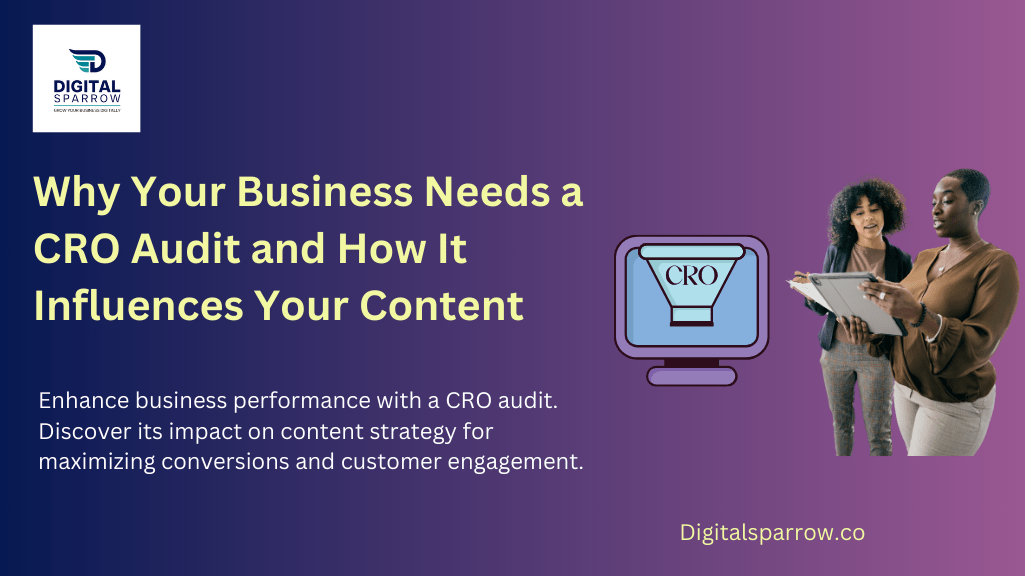In the fast-paced digital landscape of the 21st century, businesses are constantly seeking ways to improve their online presence and boost their bottom line. Optimization of conversion rates (CRO) is a crucial component of this Endeavour. The process of improving a website or landing page to raise the proportion of visitors who complete the intended activity, such as making a purchase, signing up for a newsletter, or completing a contact form, is known as conversion rate optimization (CRO).
While CRO involves a variety of strategies and techniques, conducting a CRO audit is often the first step towards achieving sustainable improvements in conversion rates. In this article, we’ll look at the significance of a CRO audit for your business and how it affects your content marketing efforts. By the end of this article, you’ll understand why a CRO audit should be a component of your digital strategy and how it may lead to content-driven success.
1. Understanding Conversion Rate Optimization (CRO)
Before we dive into the specifics of a CRO audit, it’s crucial to grasp the fundamental concept of Conversion Rate optimization. CRO is concerned with increasing your website’s or landing page’s capacity to convert visitors into customers or leads. This entails converting passive browsers into active participants in your sales funnel.
The basic purpose of CRO is to maximize the return on investment (ROI) from existing website traffic. Rather than simply getting more people, CRO focuses on making the most of the traffic you already have. It is about ensuring that when customers land on your website, they are not just surfing aimlessly but are performing important activities that help your business.
2. The Role of a CRO Audit
A CRO audit serves as the foundation for effective optimization efforts. It involves a systematic examination of your website or landing page to identify elements that may be hindering conversions. Here’s why your company needs a CRO audit:
2.1. Identifying Conversion Barriers
One of the primary objectives of a CRO audit is to pinpoint barriers that hinder the conversion process. These hurdles can take many forms, including ambiguous navigation, poor website loading times, and a lack of compelling calls-to-action (CTAs). You can begin to address these difficulties strategically by identifying them.
2.2. Analyzing User Behavior
A CRO audit involves extensive analysis of user behavior data, often collected through tools like Google Analytics. This data provides insights into how users engage with your website. It can identify which pages have high bounce rates, where users tend to leave, and what paths they take around your site. Understanding this behavior is critical for optimizing the user experience.
2.3. Testing and Experimentation
A CRO audit also lays the groundwork for A/B testing and experimentation. Through systematic testing of different elements (e.g., headlines, images, and CTAs), you can determine what resonates most with your audience and drives higher conversion rates. This data-driven approach helps you refine your website continuously.
2.4. Enhanced User Experience
A better user experience is synonymous with improved conversion rates. When users find your website easy to navigate, visually appealing, and informative, they are more likely to engage with your content and take desired actions. A CRO audit helps identify areas where UX improvements are needed.
2.5. Maximizing the Marketing Budget
CRO is about more than just increasing conversions; it’s also about making the most of your marketing spend. By increasing conversion rates, you may make better use of your advertising expenses, resulting in a higher ROI. This is especially useful for businesses with minimal marketing resources.
10-visible-seo-ranking-factors-https://digitalsparrow.co/10-visible-seo-ranking-factors/
3. How a CRO Audit Influences Your Content
Now that we understand the importance of a CRO audit, let’s explore how it can profoundly influence your content marketing efforts.
3.1. Tailoring Content to User Intent
Content is an essential component of your website, and its effectiveness has a significant impact on conversion rates. A CRO audit can assist you in aligning your content with user intent. You can determine the exact queries, problems, or wants that drive visitors to your site by analyzing user behavior data. Armed with this knowledge, you can design content that targets these issues directly, improving the possibility of conversions.
For example, if your CRO audit reveals that users frequently search for “how to choose the right running shoes,” you can develop a comprehensive blog post or video guide that answers this question. This not only satisfies user intent but also positions your brand as a trusted resource, potentially leading to conversions.
3.2. Optimizing Landing Page Content
Landing pages play a pivotal role in CRO, as they are often designed with a singular goal in mind, such as capturing leads or selling a product. A CRO audit scrutinizes these pages to ensure that their content is persuasive, concise, and relevant.
A landing page audit may uncover that it lacks a clear value proposition or engaging headlines. As a result, you can update the content to make it more appealing and to direct users to the desired action. You can drastically increase conversion rates by optimizing landing page content.
3.3. Enhancing Call-to-Action (CTA) Copy
CTAs are pivotal elements in converting visitors into customers or leads. A CRO audit can help you evaluate the effectiveness of your CTAs. It can reveal whether the language, placement, or design of your CTAs is resonating with your audience.
For example, your audit may show that visitors respond better to action-oriented CTAs like “Get Started Now” than passive ones like “Learn More.” With this knowledge, you may optimize your CTAs to correspond with user preferences, perhaps leading to improved conversion rates.
3.4. Mobile-Friendly Content
With the increased use of mobile devices, it is critical to ensure that your content is mobile-friendly. A CRO audit can reveal how effectively your content performs on mobile devices. If you realize that your content is not rendering properly or that the user experience on mobile is poor, you can make the necessary changes.
Mobile optimization isn’t just about responsive design; it’s also about tailoring content to the mobile user’s context and needs. By optimizing your content for mobile users, you create a smoother path to conversion for this significant portion of your audience.
3.5. Content Personalization
CRO audits often involve segmenting your audience based on behavior, demographics, or other criteria. This segmentation can be used to personalize your content. By delivering content that resonates with specific audience segments, you can increase engagement and conversions.
For example, if your audit finds that a specific set of visitors frequently visits your website for tech-related articles, you can build personalized content recommendations or email campaigns suited to their interests. This personal touch can help you build a closer connection with your audience and increase conversion rates.
3.6. Content for Trust-Building
Trust is a critical factor in conversions. Users are more likely to take action if they trust your brand and the information you provide. A CRO audit can highlight areas where trust-building content is needed.
For example, if your audit identifies a high bounce rate on your product pages, it might be due to a lack of customer reviews and testimonials. In response, you can priorities gathering and showcasing positive reviews to instill confidence in potential buyers.
https://startupadvice.in/bootstrapping-success-thrive-with-limited-resources/
Conclusion
In today’s digital landscape, optimizing your website for conversions is critical for business growth. A CRO audit is the first step in identifying conversion bottlenecks and improving the user experience. Furthermore, it is critical to developing your content marketing plan.
You can develop a more engaging and effective online presence by adapting your content to user intent, optimizing landing page content, boosting CTAs, guaranteeing mobile friendliness, personalizing content, and prioritizing trust-building initiatives. What was the end result? Higher conversion rates, increased revenue, and a stronger relationship with your audience.
Incorporating a CRO audit into your digital strategy is not just a one-time effort but an ongoing process. Continuously monitoring and optimizing your website based on user behavior and preferences will help your business thrive in the competitive online landscape. Ultimately, a well-executed CRO audit can be the catalyst for content-driven success and long-term growth.


作為巴黎世家的代表作之一,Balenciaga 包包系列註重包袋設計的多樣性與前衛感。balenciaga哪裡買最便宜
Adidas NMD系列自推出以來,不斷推出各種款式和配色以滿足不同消費者的需求。adidas nmd哪裡買最便宜?